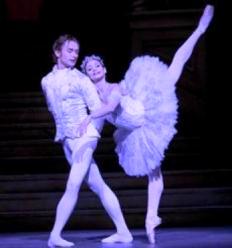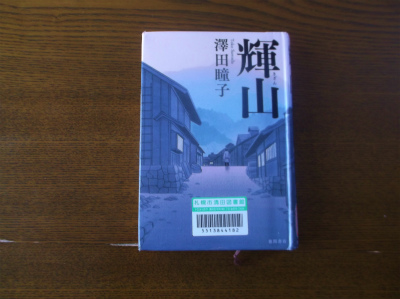Various English Topics
Various English Topics★★ Chapter 1: Miyako Yoshida
この英文では英語の全く話せなかった吉田都さんがロンドンのバレエ学校に飛び込み、持ち前のバレエの才能を生かして、ついに「世界の至宝」(The World's Greatest Treasure)と呼ばれるに至ったエピソードが描かれています。多少意味不明な語があっても、彼女のトップに登り詰めようとするパワーに引き込まれるようにして、英文を読んでみましょう。単語の確認はその後でも構いません。これは速読の良い練習になりますし、TOEIC & TOEFL の長文読解の訓練ともなります。

1. ―"Ever since I started ballet, I felt a yearning to become a ballerina. I didn't find the strict lessons to be any real strain , and I was always a model student who would just practice and practice until I could perform the movements. When my first overseas study program was decided, rather than being anxious, I felt empowered by the simple realization that I would be able to continue to pursue my dream of dancing ballet."
However, when Yoshida first started living in Britain, she was faced with a steady stream of barriers. "I really didn't like London, including the weather and food. Then there was the language barrier. When I first arrived I spoke no Enlish, and I couldn't understand what people were saying. I also couldn't explain what I wanted to get across . My first year there was quite dark and frustrating."
2.―At the Royal Ballet School, most of the students were British. Thanks to this environment, she had no choice but to throw herself into the local lifestyle. "I made a lot of British friends at the ballet school, which turned out to be a big step in the right direction for me. They helped me get along, with the language and in many other areas. Friends invited me to their homes on Christmas and on other holidays because they figured I was lonely. Being the only Japanese turned out to be an advantage."
3.―In the world of ballet, Japanese dancers have an especially difficult challenge because of physical builds different from their Western counterparts . Yoshida also came face to face with this reality. "When I first entered the school, I was simply amazed at how different everything was. In terms of extent appearance, I looked younger than other teenage girs; but at the same time, all the girls looked gorgeous just standing there."
In this environment, she became fiercely aware of being Japanese. On the technical side, however, she was confident she could hold her own. The impeccable fundamentals that she had learned in Japan became her greatest asset as she buit her career, while being in the
tough sorroundings furthered her physical strength and polished her technique. "It took me some time, but I finally came to believe in myself. As it turned out, being in that type of atmosphere made me more aware of my own identity. While being a Japanese made life complex in one respect, it was also a big supoort."
4.―Upon graduation, Yoshida was immediately accepted into Sadler's Wells (currently the Birmingham Royal Ballet), the second largest ballet company in Britain. It was
here that she encountered an instructor destined to become her mentor ―Peter Wright.
"My encounter with Peter was a big step in my career. He was like a father to me, steadily cultivating my talents, helping me master the methods of expression that are naturally difficult for Japanese and guiding me with his wise advice. Though you may be assigned to be an instructor here, you both operate an equal footing as professionals. Thus, you have to do everything on your own. If you fail to apply yourself and take the easy route in the art, nobody will scold you or try to steer you back to the correct path. You'll just be left to do as you have chosen, although they will cut you from the company if your level of expertise slides too far."
5.―In 1995, she was accepted into the Royal Ballet as the principal. This is the highest status in the world of British ballet, and also the first time a Japanese has captured that honor. "When I was chosen, I was truly delighted. But the first two or three years were a major struggle. The pressure was tremendous, and you could never let up―even at the practices or rehearsals. There was also a sense of constantly being watched by everyone around you." Yoshida is currently in her ninth year as principal during which time sha had faced many adversities including injury and disillusionment. She says that she has never taken her position for granted, and constantly strive to keep herself in top form.
Staying at the pinnacle of British ballet, a position that veteran dancers from throughout the world vie for , is certainly no easy task. "I always put 120 percent into my work and I'm constantly going all out to suceed. I feel like I'm always being pushed to the brink , never being able to let down. Then again, this may very well be the force that drives me toward improvement."
6.―In a very real sense, it is this strength, this rich passion for ballet, that has molded Yoshida into a world-renowned ballerina. "When I eventually leave the stage, I hope to cummunicate what I have learned in Britain to the children of Japan.
My identity as a Japanese has been a vital support in my success here, and I feel I have an obligation to repay that favor somewhere down the road." This world-class ballerina, bringing to her art an immaculate mix of the grace and sweetness befitting a principal, keeps a hectic schedule with performances in Britain and the United States. On tap for 2005, meanwhile, is a Japan tour by the Royal Ballet. Yoshida looks forward to performing on stage in her native land. (quoted from Bamboo Mook in English, 2004 )

≪ Words and Phrases ≫
1.― strain 「ストレス・緊張・重圧」(例) He broke down under the strain. (彼は過労のために倒れてしまった)
empowered 「権限を与えられる」
get across 「話が通じる」(例) Her speech got across to the crowd.
(彼女の演説は群衆によく分かった)
3.― physical builds 「体格」
(例) To be an excellent athlete, good physical build is very essential. (優れたアスリートになるためには、立派な体格がまずもって不可欠である)
counterparts 「同じ立場の生徒たち」
(例) I was then looking for a new type of business, and Cathy, my counterpart in America, had just started her own business. (私は新種のビジネスを当時模索中だった。アメリカ人のキャシーも同様の立場だったが、彼女はちょうど起業したばかりだった)
In terms of 「~の点から」
impeccable fundamentals
「申し分のないバレエの基礎」
asset 「財産・強味・利点」=advantage
(例) Honesty was a great asset to him. (正直なのが彼の大きな取柄だった)
furthered 「~を促進した」=advanced
4.― encountered 「偶然出会った」
destined 「運命づけられていた」
mentor 「賢明な助言者」
cultivating 「才能を高めてくれる」
assigned 「仕事を任命される」
footing 「資格」
apply yourself 「自分を適用させる」
steer 「導く」
expertise 「専門的な技術・能力」
5.― adversities 「苦労・難儀」
pinnacle 「名声などの絶頂」
vie for 「競う」=compete for
brink 「絶壁の縁」
6.― molded
「(人格などが)形成されて」
world-renowned 「世界的に有名な」
vital 「不可欠な・極めて重要な」
immaculate 「欠点のない・完全な」
befitting 「~するのに適している」
hectic 「大忙しの・忙殺されて」
On tap 「~の冒頭に」
★★ Chapter 2: The Beauty of Lipstick
皆さんは口紅の歴史をご存知ですか?古代から女性は口紅をしてきたのです。しかし19世紀英国ヴィクトリア朝時代は口紅は禁止されました。それはなぜでしょう?このようなことを頭に入れてなるべく英文のまま、読んで見て下さい。

1. ―Throughout the ages, women have used beauty
products such as lipstick, rouge and powder. By emphasizing facial features or by darkening or lightening their skin, women have always tried to make themselves look more attractive. For many women lipstick is most important beauty product. The choice of lip color can send a powerful message about a person's mood, status and personality. Perhaps that is why the avarage woman uses three kilograms of lipstick in her lifetime.
2. ―Lipstick has a very long history. We know, for instance, that lipstick was used in Babylon at least 5,000 years ago. In Egypt, Queen Cleopatra was fond of lipstick made from finely crushed carmine beetles and ants' eggs. The insects' shells produced a red color, while the eggs provided a creamy base. In the Middle Ages in Europe, lipsticks were a blend of a rich red dye made from the cochineal beetle and an oily base of beeswax . This mixture was particularly popular in England during the reign of Queen Elizabeth the First. In Japan, on the other hand, women traditionally colored their lips with a paste that used a red pigment derived from safflowers .
3. ―However, some of the ingredients used in lipstick in the past were actually quite dangerous to the wearer. On the other hand, modern lipstick is completely harmless, and is made from a variety of waxes, pigments and oils such as olive oil, castor oil, or cocoa butter.
4. ―Despite its long history, lipstick has not always met with approval , and not just because of its health risks. According to Meg Cohen Ragas and Karen Kozlowski in their book, "Read My Lips: A Cultural History of Lipstick," in 1770, the British Parliament passed a law against lipstick. The law stated that women who tricked me into marriage by wearing makeup "could be tried as witches ." In the 1880s, Queen Victoria publicly stated that makeup was impolite . Needless to say the Queen never wore any makeup herself. For almost 100 years after her reign, the only women who wore makeup in England were actresses and prostitutes .
5. ―It was not until the 20th century and the influence of American movies that women began to wear makeup again.
In the 1930s, Helena Rubinstein and Elizabeth Arden, leaders in the American makeup industry, opened their first beauty parlors. They showed women new ways to style their hair and present themselves. In addition, they taught women how to wear makeup and improve their complexions .
6. ―Even today, men and women have mixed opinions about lipstick and what it tells us about the women who wear it. In a recent survey in Europe, 25 percent of male corporate
directors said that women who wear makeup look more professional than those who do not. They say that women who do not wear lipstick
look like "they can't be bothered to make an effort." And a staggering 54 percent of female directors agree with their male counterparts.
7. ―Whether you usually use lipstick or not, Tamara Brooke, a journalist for an American beauty magazine offers this advice, "I think a naked unadorned face is beautiful. On the other hand, women should realize that if they wear lipstick, they will make a better impression. Therefore, I always advise women to wear it on important business
occasions."
(quoted from Graded Reading Series by Macmillan Languagehouse)
★ Chapter 3: Life Is Beautiful
第二次世界大戦中のユダヤ人への迫害はあまりにも有名ですが、この英文は民族虐殺の憂き目に遭いながらも、"Life is beautiful"と人生を讃えたイタリア系ユダヤ人を描いた映画のレヴューです。このタイトルの意味を念頭に置きながら英文を読んでみて下さい。

1.―The movie Life Is Beautiful is virtually a one-man show. Its writer, director and leading actor was Robert Benigni, who has been described as the Italian Charlie Chaplin or Woody Allen. The film won the Grand Prize of the Jury at the Cannes Film Festival in 1998 and nearly 30 other awards in different countries. At the Academy Awards in 1999, it won the award for Best Foreign Language Film, and Benigni even beat out that year's favorite, Tom Hanks, to win the award for Best Actor.
2.―The film is divided into two distinct halves. The first is full of laughter and happiness. The irrepressible Guido (Benigni), an Italian Jew, marries the schoolteacher, Dora, after convincing her to leave her fiance for him. The couple has a son who was named Giosue. But after Italy enters an alliance with Nazi Germany, the persecution of Jews begins. The father and son are both sent to a concentration camp . As the comedy becomes a tragedy, Guido shows his true courage by constantly trying to protect his son from the grim reality around them. "It's just a game and the winner gets a tank," he explains to the young boy, who listens innocently. "You can't seriously believe that people are burned and turned into soap, can you?"
3.― Life Is Beautiful is profoundly different from any other film that deals with the subject of the Jewish Holocaust . Benigni set himself the seemingly impossible challenge of overturning the horror of the attempted genocide of the Jews by treating it as a humorous story. Since many survivors of the
concentration camps are still alive, it was inevitable that a film that uses laughter to depict the cruel reality of the camps would raise criticism . But in the end, Benigni won far more praise than blame. Finding laughter in the midst of such overwhelming tragedy gives us the power to live. It teaches us to have the courage to face our destiny and to trust in love.
4.―Benigni's message is simple: no matter how much cruelty and suffering there is around us, life is still beautiful and worth living. He wants to tell us that it is not reality that is beautiful, but rather that beauty is reality and that human beings should live not in despair but in hope. Life is beautiful―every human being should try to say this.
(quoted from Read Up―22 Steps to Strategic Reading― )
© Rakuten Group, Inc.






